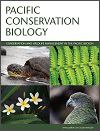Pacific Conservation Biology
Volume 30
Number 2 2024
Conservation efforts are often inhibited by a lack of information on a species; but we show it is possible to inform extinction risk with rapidly gathered data. We found that the glossy grass skink (Pseudemoia rawlinsoni) is a widespread, geographically variable species that matures in 3 years and has a generation length of 5 years. This information, in combination with other field-based studies, indicates that the glossy grass skink meets the criteria for listing as a threatened species.
Recent mapping of the activities of two European exploration parties in south-eastern Australia in the mid-19th century has provided greater detail about the collection localities of some important fauna specimens. Using Mitchell’s Hopping Mouse as a case study, this refined information about the breadth of the historical niche was compared with the current distribution and habitat (contemporary niche). The results suggest a greater range of conservation sites and actions for the species in south-eastern Australia.
We describe the events leading to establishment of Two Peoples Bay Nature Reserve. The area was long known to Noongar peoples. Mapping by Europeans in 1791 was followed by sealing and whaling in the 19th century, and after World War II plans were prepared for a townsite. After the discovery of the noisy scrub-bird (Atrichornis clamosus), hitherto believed extinct for 100 years, plans for the town were cancelled and the Reserve was established in 1967.
This article belongs to the Collection The Natural History of Two Peoples Bay Nature Reserve, Western Australia.
The dugong’s (Dugong dugon) habitat use in small coral reef lagoon systems, constrained by tides, is poorly understood, hindering adaptive management. Through aerial surveys, we examined seasonal and tidal variations in dugong utilisation in a high conservation value coral reef lagoon. This study reveals significant temporal variations in dugong habitat use, influenced by tides and seasons. It underscores the importance of outer reef habitats devoid of seagrass for the species. Additionally, it contributes evidence of behavioural thermoregulation in dugongs.
This article belongs to the Collection Marine Mammals in the Pacific.
Collaborative effort is required to prevent the decline of the threatened Pilbara leaf-nosed bat. A combination of stakeholders came together in 2013, and then again in 2022, to determine key actions required for the conservation of the species. Analysis of studies from the past decade indicates that many of the 2013 targets were largely unaddressed, meaning that higher accountability and changes such as in regulatory procedure will be required to ensure the 2022 targets are met.





